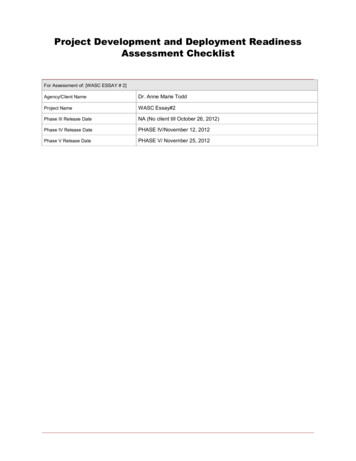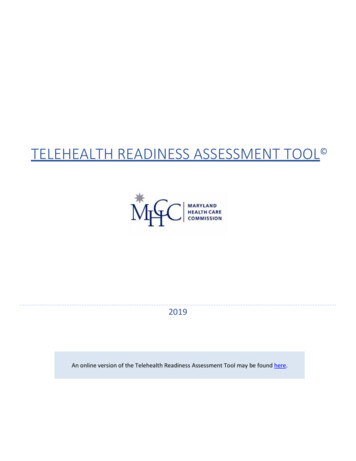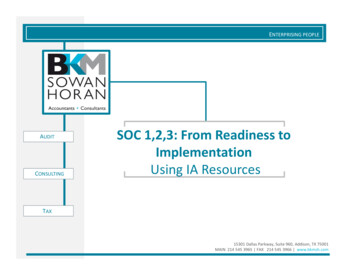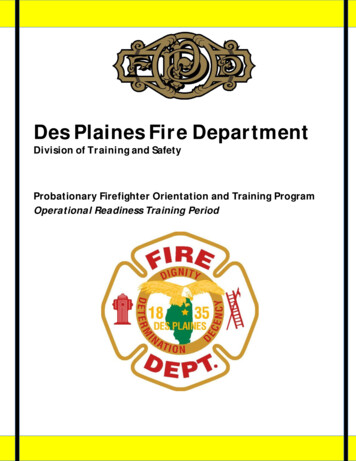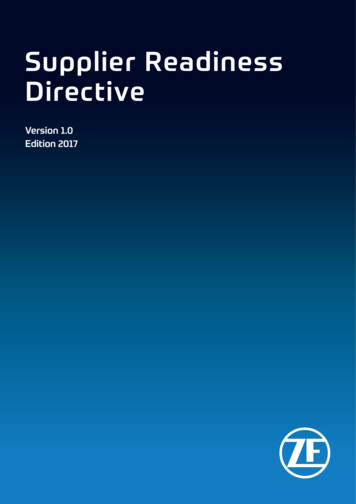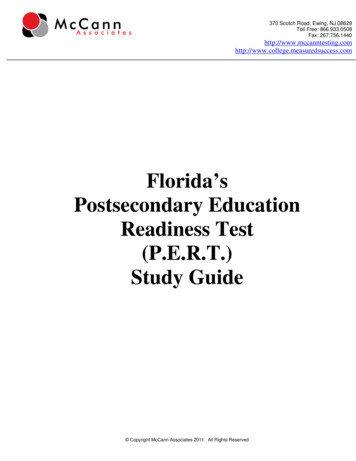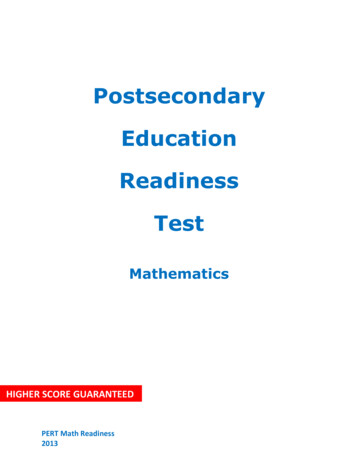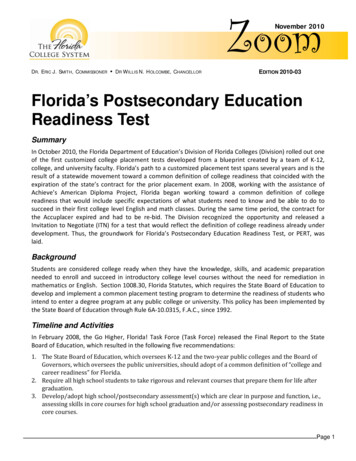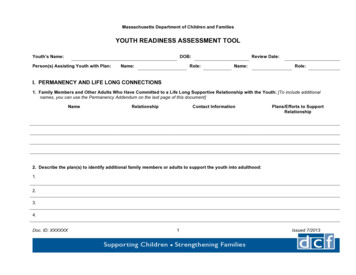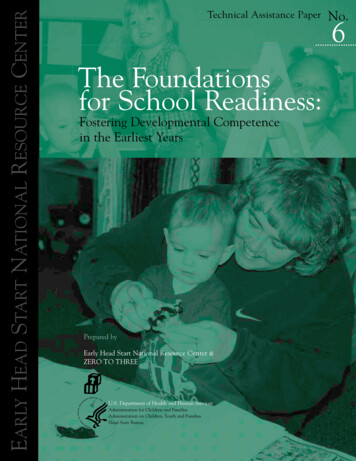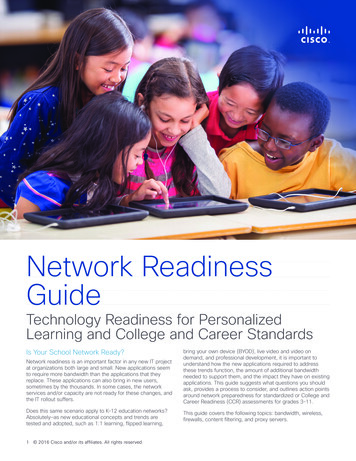
Transcription
Network ReadinessGuideTechnology Readiness for PersonalizedLearning and College and Career StandardsIs Your School Network Ready?Network readiness is an important factor in any new IT projectat organizations both large and small. New applications seemto require more bandwidth than the applications that theyreplace. These applications can also bring in new users,sometimes by the thousands. In some cases, the networkservices and/or capacity are not ready for these changes, andthe IT rollout suffers.Does this same scenario apply to K–12 education networks?Absolutely—as new educational concepts and trends aretested and adopted, such as 1:1 learning, flipped learning,1 2016 Cisco and/or its affiliates. All rights reserved.bring your own device (BYOD), live video and video ondemand, and professional development, it is important tounderstand how the new applications required to addressthese trends function, the amount of additional bandwidthneeded to support them, and the impact they have on existingapplications. This guide suggests what questions you shouldask, provides a process to consider, and outlines action pointsaround network preparedness for standardized or College andCareer Readiness (CCR) assessments for grades 3–11.This guide covers the following topics: bandwidth, wireless,firewalls, content filtering, and proxy servers.
BandwidthHow much bandwidth will standardized orCCR assessments be required at my school?There are several online calculators that provide bandwidthguidelines. Some are affiliated with Partnership forAssessment of Readiness for College and Careers (PARCC),Smarter Balanced Assessment Consortium (SmarterBalanced), or state-based assessments, while others may beunaffiliated. Be aware that if you choose a tool and providethe input and then run several other tools using identical inputdata, you will likely get very different results.Much of the reason for this difference in results is theassumptions. We suggest that you begin with a discoverybaseline using a relatively simple calculation, and use thisbaseline throughout the rest of your network readinessplanning.How do I measure what else may be happening onthe network during assessment days to ensure thatenough bandwidth is available for the assessments?While preparations can be made ahead of time to understandbackground traffic, network applications and traffic aredynamic and can change quickly. Network traffic may changeon assessment day without the knowledge of technical staffand may cause assessments to be affected. This scenariomay require immediate action to assess and remediateimpacted background traffic.Make sure you have network visibility tools ready beforehandto identify and remediate background traffic if necessary.How do I ensure that enough bandwidth is availablefor the assessment on test days, regardless whatelse may be happening on the network?Action:Calculate a discovery baseline for bandwidth:(Number of classrooms taking tests simultaneously) x(Number of testing devices per classroom) x (30 to 100Kbps per device) Discovery Baseline Estimated TotalBandwidth in KbpsThis is a discovery baseline during an assessment testwindow, in Kbps. If you need to convert to Mbps or Gbps, usean online calculator such as iCalc:www.ibeast.com/content/tools/band-calc.aspWe are assuming a range of 30 to 100 Kbps per device,based upon estimates from PARCC and Smarter Balanced.We recommend using the higher end of the range, so thatschools are prepared for any spikes in usage that may occur.If you have information from your assessment organizationthat indicates a higher range, use this range.You can also apply this formula to any location with yourschool district. For example, you can apply a baseline to aparticular building getting to an aggregated district core, to allbuildings aggregating to the Internet connection going towardthe assessment service, etc.Once you have a discovery baseline, think about the networkpath from the student’s device to the testing service inthe cloud. Work through the entire path, including yourInternet service provider connection, to come up with themaximum bandwidth for each. Compare the baseline to thelowest bandwidth in the path from the device itself (wired orwireless) to the assessment test center. This will give you aninitial answer as follows: The CCR online assessments willrequire (discovery baseline) and we have maximum (lowestbandwidth) available today for the assessments.2 2016 Cisco and/or its affiliates. All rights reserved.To ensure that enough bandwidth is available, enable qualityof service (QoS) in your network and prioritize student testtraffic to “mission critical” status. This can be done by buildinga list of standardized or CCR assessment hosts and URLs,then marking this traffic as critical on the inbound sides of thetraffic flows, including from the Internet and student systemsports.Use a network management tool to apply your policy to thenetwork. The policy tells the network switches and routersto reserve network bandwidth for assessment traffic, makingsure that at least the amount (for example, percentage)that you specify is always available for outbound traffic.Other traffic will be delayed slightly or shaped to fit withinthe remaining bandwidth available. This allows studentassessments to always get through, no matter what othertraffic may be using the network at that time.Action:Once you have a discovery baseline for assessmentbandwidth, ensure that this bandwidth is always availableby implementing QoS and using traffic marking andprioritization. Deploy network management tools that showwhat is happening on the network in real time, streamlineconfiguration across multiple switches and routers, andmonitor the prioritized traffic flows.
Do you classify applications running on yournetwork today? Do you receive detailed reportsabout usage?How much total bandwidth do you have available tothe Internet today?To understand how assessment load will affect your network,it is critical to understand what applications currently utilizeyour network.While your Internet service provider probably offers peakbandwidth times, conduct repeated network performancetests at various times throughout the school day to assessactual bandwidth availability.Action:Action:As mentioned above, look into network equipment featuresthat can monitor and report all applications that are in useand provide a time-based history of usage. This is critical todevelop understanding of existing applications and how theymay impact assessments.Develop a daily, automated, and measureable routine to testInternet bandwidth availability.How much total bandwidth do you currently haveavailable between school buildings?Are the applications currently running on yournetwork prioritized to handle the most criticalfunctions first?Using hardware priority queues and management, criticalapplications, such as student assessments, can be givenhighest priority to ensure that they are not affected by othertraffic loads.Action:The bandwidth and network utilization between schoolbuildings will be different than Internet bandwidth, but it is justas critical.Action:Create a network map of all school buildings, how theyinterconnect, and what bandwidth they have available. Lookinto network management tools that monitor how bandwidth isutilized throughout the day.Develop a QoS implementation plan that guaranteesassessment traffic will not be impacted by other applicationbursts from elsewhere on the network.What is the utilization of your main Internetconnection today (in percentage)?If you are running a very high utilization (above 80 percent)without prioritization, any added load may cause assessmentsto time out or have severe delays.Action:Look into network management tools that monitor all networkinterfaces, including the inbound/outbound Internet usage.3 2016 Cisco and/or its affiliates. All rights reserved.Do you plan to use network caching (or PARCC/Pearson Proctor Caching) to reduce Internetbandwidth requirements?Make sure that your network caching solution works properlywith your assessment services and does not interfere.Action:Evaluate your current network caching deployment andensure it actually reduces assessment Internet bandwidth.Understand load limits and test caching configurationthoroughly before actual student test loads.
WirelessWill students be using wireless devicesfor assessments?Understand how many wireless devices can be active at onetime for wireless network load. Is there more or less load on atest day? Look into the wireless standards, performance, andcapabilities of the devices.Action:Perform a wireless survey to make sure the existing wirelessinfrastructure can handle assessment loads. Test heavywireless density ahead of time. Take remedial action ifnecessary.If students will be using wireless, how many studentassessment devices will be using one access point?Determine whether the wireless infrastructure is designedto handle the activity of 20 or more students per classroomsimultaneously. Additional access points may be neededdepending upon student-to-access point ratio.Based on your earlier response, is the local network(routers, switches, and wireless controller) capableof handling all the aggregate traffic from theaccess points?Installing 802.11ac access points to provide extra bandwidthto students requires the infrastructure to handle larger loadsof traffic.For example, if you install 10 new 802.11ac access points,each with a 1 Gbps wired uplink, the maximum performanceper access point is 1 Gbps. If the core wireless switchingarchitecture cannot handle 10 Gbps of traffic from theseaccess points alone, then they will not be able to deliver 1Gbps per access point.Action:If an older, lower-performing switching infrastructure is inplace today and the wireless access points are capable offaster performance, consider replacing it with infrastructurethan can handle an aggregated wireless load to avoid lowerend-user performance.Action:Consider replacing older access points with ones that aremore capable of handling additional traffic and devicessimultaneously. Enable load balancing across multiple accesspoints so single units are not overloaded.If students are using wireless, what wireless speedand performance standard do you use (802.11b,802.11b/g, 802.11b/g/a, 802.11n, 802.11acWave 1 or Wave 2)? Dual-radio or single-radio?Older 802.11b can only provide 11 Mbps per access point(about 5.5 Mbps actual throughput), while newer 802.11acWave 1 can provide up to 1.5 Gbps per access point (about750 Mbps actual throughput; also may be limited by 1 Gbpswired uplink). 802.11ac Wave 2 can provide even morewireless bandwidth, as end devices are able to support thenew protocol. If your access points are older, they may beoverloaded by performing assessments from many devices atonce.Also, WPA2 Personal (WPA-PSK) and WPA2 Enterprise(WPA-802.1x) must use Advanced Encryption Standard (AES)to achieve full 802.11n performance. Bandwidth is limitedwhen using Temporal Key Integrity Protocol (TKIP).Action:Consider replacing older access points with ones that aremore capable of handling additional traffic and devicessimultaneously.4 2016 Cisco and/or its affiliates. All rights reserved.How do student wireless devices authenticate intothe network?If you do not have per-student authentication into the networktoday, is it required for access into assessments? Is it criticalthat only students that are testing use the network duringtests and not allow guest access during this time?If you do have wireless authentication using WebAuth, theremay be time out settings that require users to reauthenticateperiodically, and this may occur during an assessment.Some assessments require that no other applications canbe accessed during the test, therefore the wirelessre-authentication pop up will not appear, nor can it beswitched to during the test. The test will lose the connectionto the server.Consider using 802.1x authentication, which will not prompt are-authentication pop-up notice.Action:Enable an authentication system that tells you exactly whois logged into the network and from what location to reducefraudulent testing. Ensure that the wireless authenticationmechanism, such as WebAuth, will not time out during a testas it results in a lost connection and requires students to reauthenticate.
Is wireless network traffic encrypted betweendevices and access points?Smarter Balanced assessments use dedicated, securebrowsers on each student device. PARCC utilizes specificversions of existing browsers with SSL enabled. Statesponsored assessment organizations may use somethingsimilar or different. However, it is a best network practice toencrypt all wireless traffic between endpoints and accesspoints. Considerable traffic, sometimes including login namesand passwords, is unencrypted by applications today, and canbe easily captured by any device within wireless range.Action:Enable encrypted transport by requiring WPA2 or AESencryption for all wireless devices. WEP security is considerednon-secure and should be avoided.Do you have complaints from students or facultythat their devices sometimes “drop off” the networkrandomly and can’t get back on?This may indicate that your wireless network has becomeunstable, overloaded, or needs maintenance work.Action:Look into wireless network management tools that trackwireless coverage, find weak spots, eliminate rogue accesspoints, and boost signal where it is needed.5 2016 Cisco and/or its affiliates. All rights reserved.If you are using wireless, how do you currentlymonitor the wireless network for outages?Do you have a wireless network control panel that showsactive connections and trouble alarms when wirelessproblems occur?Action:Look into network monitoring tools that alert staff aboutoutages so they are able to take action quickly to resolveissues.Will students be using only wired desktop (lab)computers for assessments?Make su
Network traffic may change on assessment day without the knowledge of technical staff and may cause assessments to be affected. This scenario may require immediate action to assess and remediate impacted background traffic. Make sure you have network visibility tools ready beforehand to identify and remediate background traffic if necessary. How do I measure what else may be happening on the .
